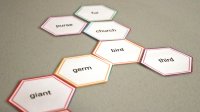Developing Early Literacy Skills With Hexagonal Thinking Strategies
Hexagonal thinking can enhance literacy instruction by encouraging students to make connections between sounds, words, and meanings.
Hexagonal thinking is a highly effective, versatile learning strategy that helps students see connections between various concepts. It was created by Betsy Potash as a critical thinking activity that is frequently used in social studies, science, and language arts.
During the activity, students place hexagons next to each other to visually show a connection. For each connection, they must also be able to share a rationale. This strategy therefore allows teachers to gain insight into students’ thinking and to potentially correct misconceptions in real time.
Students can work individually to complete the activity, but its real power manifests when they work in pairs or groups. It’s a “low floor/high ceiling” activity, meaning it’s accessible and has a high yield on learning.
As a special education teacher working with fourth-grade students of varying abilities, I wondered how I could utilize this strategy when teaching reading. Learning how to read requires, at minimum, two major abilities: decoding and language comprehension—the end result of which is reading comprehension.
When students struggle either with their ability to decode or with their language comprehension, the consequence is that they also have difficulty comprehending what they read. Using hexagonal thinking in my classroom allows me to engage students while differentiating instruction to meet various student needs. It allows me to provide scaffolding and feedback in the moment. And students love completing a learning activity that feels like a puzzle.
I’ve used this approach to teach relationships between phonemes (sounds), orthography (spelling), syntax (parts of speech), and morphology (meaning).
Phonemes
One of the earliest and most essential skills that children learn is to rhyme. They learn that hat and bat end the same way, with the -at ending. As they progress, they learn about the individual sounds that make up the word hat: /h/-/a/-/t/. They also begin to isolate sounds like the /a/ in the middle.
Hexagonal thinking can support and promote this skill. For novice learners, you can use a forced-choice approach, asking students to identify all of the words, for example, that have the same middle sound: hat, cat, rat, bat.
The students can tell you what all of these words have in common. For striving learners, you can prompt them to tell you the differences: Hat starts with /h/, for example, while bat starts with /b/. For less scaffolding, you can provide cards with multiple middle sounds and multiple beginning and/or ending sounds, therefore challenging your learners.
Orthography
Spelling is a more challenging skill for students to acquire. Hexagonal thinking requires students to slow down and look for orthographic patterns in words. For example, the words twice and ice both have a soft c sound because the c is followed by an e.
You can further challenge your students by sharing two words with the same sounds but different spellings. They can place the words cow and loud next to each other and work to discover and provide an explanation that the two words have the same sound, but one uses -ow to spell that sound, while the other uses -ou.
Syntax
Another use for hexagonal thinking is making connections between the functions of words. Using patterns that students have already learned, you can create hexagons that also fall into the categories of noun, verb, or adjective.
Here, again, you can provide maximum scaffolding by color-coding or using words from one category, or you can have your students determine what categories the words represent. This approach would be ideal for categories like concrete and abstract nouns, various forms of the verb “to be,” action verbs, and common or proper nouns.
Morphology and Vocabulary
Morphemes are the smallest unit of meaning in language. Morphemes include prefixes (re-, un-, dis-), suffixes (plural -s and -es), base word (like run in the word running), and root words (like -ject in the word interject).
You can give younger and novice learners words that share a prefix, such as unkind, undo, and unable, and then ask them to explain what those words have in common and how the prefix changes each base word. With students who are ready for an extra challenge, consider giving them words that have a shared root word, and ask them to explain how the words are related—for example, phone, megaphone, phonograph, and symphony.
Vocabulary takes it a step further and allows students to work with synonyms, antonyms, and even shades of meaning. I had students create a hive of words that share an essential meaning but vary in degree of similarity, as in this set of words: stroll, jog, run, and sprint. This activity offers students the opportunity to engage in rich discourse, not only about the concrete meaning of each word, but in the nuances of each word as well.
Deepening Literacy
Some children will naturally see connections between words and literacy concepts; however, most students will need multiple exposures to words through deliberate practice in order to achieve mastery. Deliberate practice includes a specific goal, a high level of engagement, and coaching or feedback throughout the process. Hexagonal thinking meets that goal.
For educators catering to students with diverse learning needs, hexagonal thinking presents a dynamic approach to teaching reading skills. Its structured format allows for scaffolding and personalized feedback, catering to individual student abilities, and facilitating a deeper understanding of fundamental reading components such as phonemes, orthography, syntax, and morphology.
By encouraging students to analyze relationships between words and their meanings, hexagonal thinking promotes vocabulary development and cultivates comprehension skills essential for proficient reading.
